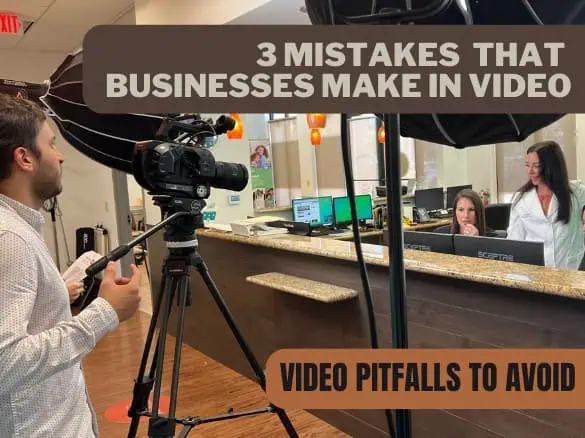3 Mistakes That Business Make Related to Video
Why Is This Important?
Video is an indispensable tool in the corporate arsenal, serving to engage audiences, showcase brand strength, and simplify the delivery of complex business messages. Yet, the journey from concept to execution is fraught with potential pitfalls that can undermine a project’s success. This guide identifies three common mistakes made in video production, explores why these errors occur, and outlines multiple strategies for each, ensuring your video content achieves its intended impact.
Undefined Video Objectives
Overview
A frequent oversight is entering into a video project without clearly defined objectives. This lack of direction can lead to content that fails to address any specific audience needs or business goals, resulting in poor engagement and wasted resources. Videos created without specific goals tend to lack focus, resulting in content that neither resonates with the target audience nor meets business needs effectively. This can lead to viewer disengagement and diminished returns on investment.
Why It Happens
Businesses often rush the pre-production phase due to tight deadlines or underestimation of the planning required. This haste leads to vague, unfocused video content that may lead to failure before it even begins.
Solutions
Strategic Planning Session: Before any filming begins, conduct a preproduction meeting to map out the video’s purpose, determine what must be included, what can be excluded, etc. The reason we mention what can be excluded is that sometimes saying everything is like saying nothing. No information will be retained by the viewer if there’s too much information.
In the meeting, the focus should be on deciding whether it’s for brand awareness, lead generation, or customer education. Doing this early in the process guides the remaining production choices.
Consult with Stakeholders: Engage various stakeholders within the company, including marketing teams, sales departments, and executive leadership, to align the video’s goals with broader business objectives.
Set Measurable Targets: Define what success looks like for the project. Whether it’s views, shares, or direct leads, having measurable targets helps focus the video’s content and allows for success evaluation post-release.
Ignoring the Target Audience
Overview
Videos that fail to consider the specific preferences and challenges of their intended audience often miss the mark, leading to disengagement and ineffective communication. Videos that are not audience-specific can come across as generic or irrelevant, failing to engage viewers or inspire action.
Why It Happens
There can be a disconnect between the video creators and the actual market needs, often due to insufficient research or a one-size-fits-all approach to content creation. Sometimes an unclear target audience description or needs analysis is causing this.
Solutions
Successful video content speaks directly to its audience’s interests, needs, and challenges.
Audience Research: Invest significant time in understanding your audience’s demographics, preferences, and pain points. Tools like surveys, social media analytics, and customer feedback provide valuable insights. The more you can speak to these during the preproduction meeting, the better.
Persona Development: Create detailed buyer personas that represent your typical audience needs. Tailoring your messaging and presentation styles to these personas can greatly enhance the video’s relevance and appeal. Speak to your audience’s preference, pain points, and typical online behavior. Use this data to craft videos that address these aspects using their tone and some visuals that resonate with their demographic.
A/B Testing: Experiment with different versions of your video with small segments of your audience to determine which resonates the most. This feedback is crucial for fine-tuning the final product.
Compromising on Production Quality
Overview
Skimping on production quality can tarnish your brand’s image and send a message of unprofessionalism, significantly affecting the video’s reception and effectiveness. Poor quality (audio or visual) can severely undermine the perceived value of your brand and message. It’s too competitive out there, don’t let your branding quality remove you from competing.
Why It Happens
Budget constraints or a lack of understanding about the importance of high-quality production standards can lead businesses to cut corners. Ultimately, the client is in control, but our job is to ensure quality is as high as possible.
Solutions
Hire Professionally: Even with limited budgets, using high-quality video production teams who have the proper equipment for the production phase can make a substantial difference.
Skilled Professionals: Hiring experienced videographers, directors, and editors can elevate the production value of your video, enhancing its professional appeal. This applies to the quality of items like clear audio, stable and high-definition visuals, good lighting, and professional editing. These items, together, elevate the viewer’s experience and enhancing the credibility and appeal of your content.
Post-Production Focus: Allocate sufficient resources to editing, which can significantly improve the quality of the final video, making even less-than-perfect footage look exceptional. This is where the magic happens and where we believe we stand out.
Conclusion: Easy Fixes to these Mistakes
Navigating the complexities of video production requires a keen understanding of what can go wrong and how to steer clear of these pitfalls. By defining clear objectives, deeply understanding your audience, and refusing to compromise on quality, your business can produce compelling, impactful video content. Reflect on these questions to further enhance your approach:
- How can we better integrate video content into our overall marketing strategy?
- What are the latest trends in video production that we should consider for future projects?
- How do we measure the success of our videos more effectively to ensure continuous improvement?
By considering these questions, businesses can not only avoid common mistakes but also continuously elevate their video production efforts to better meet their strategic goals.
Related Content:
Don’t Think You Need to Invest In Video? Time and Again We Help Businesses Avoid These Mistakes!










